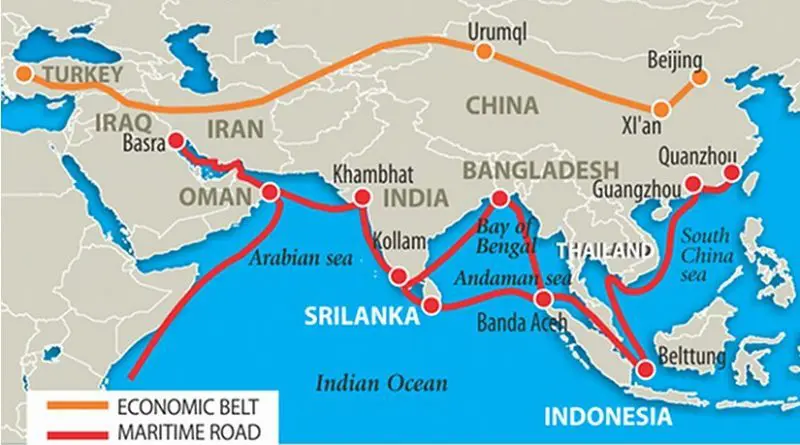Belt And Road And US-China Relations In 2018 – Analysis
By IPCS
By Rajeshwari Krishnamurthy*
In early February 2018, US forces conducted air operations targeting both the Taliban and the East Turkestan Islamic Movement (ETIM) in Afghanistan’s north-eastern Badakshan province which shares a border with China’s Xinjiang Uyghur Autonomous Region. The US is visibly interested in co-opting China in the region rather than contesting it. And, in the backdrop of emerging regional developments, China’s Belt and Road Initiative (BRI) and the China-Pakistan Economic Corridor (CPEC) may be poised to become key determinants in the Washington-Beijing relationship in South and Central Asia.
Timing and Context
Referring to the strikes, the Commander of the NATO Air Command Afghanistan Air Force Maj Gen James Hecker said, “The destruction of these training facilities prevents terrorists from planning any acts near the border with China and Tajikistan.” Responding to a question on the strikes, China’s Foreign Ministry Spokesperson Geng Shuang said, “…We stand ready to continue strengthening pragmatic cooperation in fighting terrorism with all other parties based on the principle of mutual respect, equality and mutual benefit so as to jointly maintain international and regional peace and stability.” The operative words here are “pragmatic cooperation,” “mutual benefit,” and “jointly maintain.”
The timing of the strikes is important. They took place soon after reports emerged that China is in talks with the Afghan government to establish a military base for Afghan troops in Badakshan province (Kabul has confirmed but Beijing has officially denied it); a month after Beijing and Islamabad invited Kabul to join CPEC; and days before China’s State Councillor Yang Jiechi visited Washington. This is at a time when Russia is mobilising the Collective Security Treaty Organisation and the Shanghai Cooperation Organisation’s Afghanistan Contact Group to address security issues along the Central Asian borders with Afghanistan.
Beijing is also actively engaged in various peace process formats in Afghanistan and has for long maintained a direct communication channel with the Taliban. Meanwhile, the US-backed Quadrilateral Coordination Group comprised of the US, China, Afghanistan and Pakistan has been rendered dead-on-arrival, and the Russia-backed process in which China is a major partner is broader and brings more regional countries to the table. China has initiated the Quadrilateral Cooperation and Coordination Mechanism, a security alliance on counter-terrorism involving intelligence-sharing and training with Afghanistan, Pakistan and Tajikistan. It is is part of a trilateral arrangement with Islamabad and Kabul; and in the past, Chinese and Tajik troops have held joint drills in Ishkashim district in Tajikistan’s Gorno Badakhshan Autonomous Region bordering Afghanistan’s Badakshan province.
This places Beijing in a unique position in the region. Although a China-built military base in Badakshan will have a bearing on US presence and influence in Afghanistan, Washington seems to view co-opting Beijing as more beneficial than contesting it. US actions suggest that it may be offering China a potential partnership role for closer alignment between the two. Beijing has long considered ETIM a threat, and cooperation on countering it—designated as a terrorist organisation by the US in September 2002—provides a “mutually beneficial” launch-pad for the US to enhance regional engagement with China.
Additionally, that the US strikes in Badakshan took place less than a month after Liu Jinsong took over as China’s new ambassador to Afghanistan is telling. Liu’s personal and professional background is fitting for promoting BRI objectives, especially CPEC. He was raised in Xinjiang; was the director of the Silk Road Fund in 2015 when Pakistan and China formally agreed to commence work on the US$ 46 billion CPEC project; was a deputy director in the Chinese foreign ministry’s international economic cooperation office; and until recently, was the deputy chief of mission at the Chinese embassy in New Delhi.
US is likely to find CPEC non-problematic—perhaps even useful—provided China uses it as leverage to align Pakistani foreign policy towards the US’ current objectives on transnational terrorism and Afghanistan’s economic progress. Yet, it is certainly not lost on Washington that China could gain the capability to influence regional developments via CPEC – a component of BRI – as seen in the invitation to Afghanistan. Liu’s appointment demonstrates that China is seeking increased engagement with Afghanistan, one directly aligned with BRI via CPEC.
If China were to actively compete with the US for a ‘security provider’ role in the region—which the BRI will enable it to—the US will not find it favourable. Thus, the US attempt to woo China could be viewed as a two-pronged approach: co-opting China (or at least decelerate its growing proximity to Russia); and ensuring that the Washington has more room to manoeuvre, possibly by aligning its hard power with Beijing’s soft power as China makes inroads into Afghanistan and Central Asia.
Washington may be attempting to pragmatically employ the ‘regionalise’ component of its R4+S strategy by courting Beijing. However, it is unclear whether this approach is conditional on the US retaining its ‘primacy’ in the region. Nonetheless, despite rhetoric, the US seems sceptical of regional actors taking on more active roles in the region.
Looking Ahead
Washington’s signalling has delivered Beijing’s curiosity, but its willingness to “jointly maintain” regional peace and stability might ultimately determine the level and duration of Beijing’s attention.
Suffice to say, in 2018, the US will demonstrate a lot more interest in CPEC. Additionally, BRI and Central Asia will likely be in focus throughout the year, particularly in the run up to the second US-China Diplomatic and Security Dialogue, scheduled to take place before July 2018.
* Rajeshwari Krishnamurthy
Deputy Director, IPCS
Email: [email protected]

